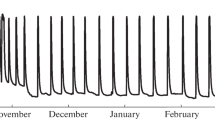The study collated oscillations of body temperature of С57BL/6 mice and Roborovski hamsters (Phodopus roborovskii) in the period range of 100-240 min and fluctuations of the secondary cosmic rays reflected by neutron count rate of a neutron monitor at the Earth’s surface. Cross-correlation of body temperature and neutron count rate data revealed their strong association only for simultaneous measurements. Collation of the phase of neutron count rate fluctuations with maxima of body temperature oscillations revealed the coincidence of the phases of both processes. There was a temporary connection between the periods of body temperature elevation and neutron count rate rise. Thus, not only the spectral parameters of biological and physical processes, but also their phases coincided, which corroborates the hypothesis on stimulating effect of increasing neutron count rate on activity of the animals.
Similar content being viewed by others
References
Anisimov SV, Shikhova NM, Dmitriev EM, Mareev EA. Mechanisms for the formation of electric-field pulsation spectra in the near-surface atmosphere. Radiophysics Quantum Electronics. 2001;44(7):520-532. doi: https://doi.org/10.1023/A:1017905732496
Deshcherevskii AV, Sidorin AYa, Kharin EP. Influence of heliogeophysical factors on animal activity under laboratory conditions. Dokl. Biol. Sci. 2005;401(1-6):139-143. doi: https://doi.org/10.1007/s10630-005-0067-0
Diatroptova MA, Diatroptov ME. Amplitude of One-Minute Fluctuations of Secondary Cosmic Rays as a Marker of Environmental Factor Determining Ultradian Rhythms in Body Temperature of Laboratory Rats. Bull. Exp. Biol. Med. 2021;172(1):105-110. doi: https://doi.org/10.1007/s10517-021-05341-x
Diatroptov ME, Diatroptova MA. Association of Infradian Rhythms of Motor Activity, Concentration of Glucocorticoid Hormones, and One-Minute-Step Oscillations of Body Temperature with Intensity of Fluctuations of Secondary Cosmic Rays. Bull. Exp. Biol. Med. 2022;172(5):592-597. doi: https://doi.org/10.1007/s10517-022-05443-0
Diatroptov ME, Slesarev SM, Zenchenko TA. Phase Analysis of Ultradian Rhythms of Body Temperature in Laboratory Mice Maintained under Constant Illumination at Different Longitudinal Locations. Bull. Exp. Biol. Med. 2021;172(1):72-76. doi: https://doi.org/10.1007/s10517-021-05334-w
Martynyuk VS, Vladimirskii BM, Temur’yants NA. Biological rhythms and environmental electromagnetic fields. Geofiz. Protsessy Biosfera. 2006;5(1):5-23. Russian.
Blessing W, Ootsuka Y. Timing of activities of daily life is jaggy: How episodic ultradian changes in body and brain temperature are integrated into this process. Temperature (Austin). 2016;3(3):371-383. doi: https://doi.org/10.1080/23328940.2016.1177159
Blum ID, Zhu L, Moquin L, Kokoeva MV, Gratton A, Giros B, Storch KF. A highly tunable dopaminergic oscillator generates ultradian rhythms of behavioral arousal. Elife. 2014;3:e05105. doi: https://doi.org/10.7554/eLife.05105.
Bourguignon C, Storch KF. Control of rest:activity by a dopaminergic ultradian oscillator and the circadian clock. Front. Neurol. 2017;8:614. doi: https://doi.org/10.3389/fneur.2017.00614
Goh GH, Maloney SK, Mark PJ, Blache D. Episodic ultradian events-ultradian rhythms. Biology (Basel). 2019;8(1):15. doi: https://doi.org/10.3390/biology8010015
Grant AD, Newman M, Kriegsfeld LJ. Ultradian rhythms in heart rate variability and distal body temperature anticipate onset of the luteinizing hormone surge. Sci. Rep. 2020;10(1):20378. doi: https://doi.org/10.1038/s41598-020-76236-6
Honma KI, Hiroshige T. Endogenous ultradian rhythms in rats exposed to prolonged continuous light. Am. J. Physiol. 1978;235(5):R250-R256. doi: https://doi.org/10.1152/ajpregu.1978.235.5.R250
Kozlov VI, Kozlov VV. Galactic cosmic ray fluctuation parameter as an indicator of the degree of magnetic field inhomogeneity. Geomagnet. Aeronomy. 2011;51(2):187-197. doi: https://doi.org/10.1134/S0016793211010075
Author information
Authors and Affiliations
Corresponding author
Additional information
Translated from Byulleten’ Eksperimental’noi Biologii i Meditsiny, Vol. 173, No. 1, pp. 108-114, January, 2022
Rights and permissions
About this article
Cite this article
Diatroptov, M.E., Diatroptova, M.A. & Surov, A.V. Ultradian Near 2-4-h Rhythms of Body Temperature in Laboratory Rodents Depend on External Environmental Heliogeophysical Factor Reflected by Neutron Monitor Count Rate. Bull Exp Biol Med 173, 92–97 (2022). https://doi.org/10.1007/s10517-022-05500-8
Received:
Published:
Issue Date:
DOI: https://doi.org/10.1007/s10517-022-05500-8



